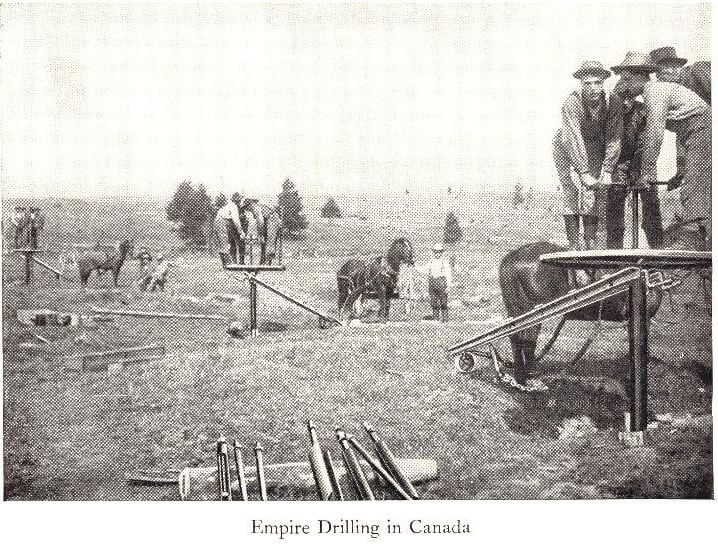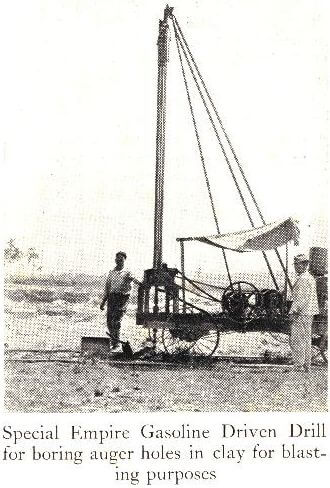Table of Contents
Placer Prospecting Practice
Prospecting methods have been developed and well established within the last few years. Sinking pits and shafts generally gives good results, but this work is usually expensive and generally slow and troublesome, owing to the presence of water in most placer ground or to the necessity of timbering the shafts. With the large amount of water flowing in from the bottom of the shaft, together with the running ground, it is most difficult to get an accurate sample of the ground. Owing to the troubles mentioned, the pits are often too few in number to determine accurately the actual mineral content of the ground in question.
The drilling method has generally been adopted, on account of the greater number of holes that can be sunk at a comparatively small cost. The mineral contents can be accurately determined by this method, granting of course, that the man in charge of the work is experienced and fully competent to make his estimates. The number of holes to be drilled in a certain area of ground cannot be determined beforehand; it will depend on whether the valuable metals or minerals appear to be generally and evenly distributed over a large area of ground or whether the deposit has a few rich pay channels or is generally spotty. For ordinary calculations one hole to the acre is considered fairly close prospecting work.
There are today, well-known mining engineers with ample experience, who are thoroughly competent to determine the value of a gold-dredging project. This was not so a few years ago, as most of these engineers were obliged to gather their experience and knowledge in the active field of operations. Many failures of the earlier days would have been avoided if the experienced engineer in gold dredging had been available.
Too much emphasis cannot be laid on the proper prospecting of the property; the old prospecting methods formerly employed, such as panning here and there, shaft sinking and steam drilling often proved expensive and unreliable. We designed and built the Empire Drill for the particular purpose of prospecting placer ground. It will drill your ground with greater accuracy and less cost than any other apparatus. It will enable you to finance your proposition more easily because it gives the absolutely accurate information which investors demand today before investing their capital.
Drill Boats
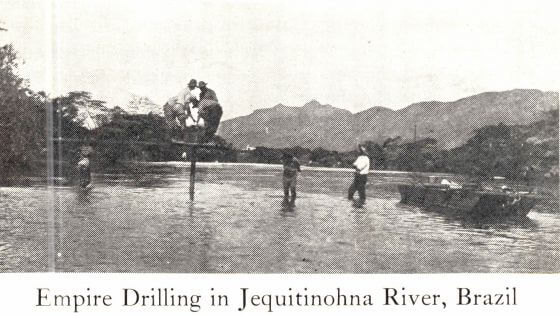 Prospecting in shallow streams may be done with the Empire Drill in the usual manner as illustrated, or a raft may readily be constructed from which the drill can be operated. For prospecting river deposits, where the river is of considerable width and depth and has a swift current, we recommend the use of one of our drilling boats. We have designed and built several of these boats; equipping them with various sizes of casing. One that we built for prospecting diamondiferous gravel in the Belgian Congo was designed to use an 18-inch casing with a small orange-peel bucket operating inside of it. This drilling boat was used for some two or three years with great success, sinking many holes and proving up a large area of ground.
Prospecting in shallow streams may be done with the Empire Drill in the usual manner as illustrated, or a raft may readily be constructed from which the drill can be operated. For prospecting river deposits, where the river is of considerable width and depth and has a swift current, we recommend the use of one of our drilling boats. We have designed and built several of these boats; equipping them with various sizes of casing. One that we built for prospecting diamondiferous gravel in the Belgian Congo was designed to use an 18-inch casing with a small orange-peel bucket operating inside of it. This drilling boat was used for some two or three years with great success, sinking many holes and proving up a large area of ground.
Special Drilling Apparatus
On account of our extensive experience in drilling soft ground, we have often been called upon to design and build drilling apparatus for conditions for which no regular standard drilling equipment is made. This includes power drills for drilling 6-inch or 8-inch holes in clay overburden, to a depth of 15 or 20 feet, in a phosphate deposit, the holes being used for blasting purposes.
In many cases we modify the Empire Drill equipment to suit particular conditions, such as in prospecting for bauxite, diamonds, sand and gravel deposits for building purposes, also various kinds of clay deposits.
Placer drilling has of late been the subject of much discussion. We herewith quote from an article entitled “Placer Prospecting Practice,” written by A. C. Ludlum and originally published in Mining and Metallurgy, November, 1921. This article sets forth the various causes tending to make the Empire Drilling method accurate, and cites some proofs of the accurate work that has been done with this drill.
Placer Prospecting Practice
Accurate sampling of placer ground being the desired object, I offer some observations of my own on hand drilling operations with rotated casing, believing that these suggestions may be of help toward obtaining the one object most desired, that is, accurate work.
In most of the drilling work that has come under my observation, only a 4 inch pipe or casing has been used, nevertheless some very excellent results have been obtained with this size casing.
“I believe accurate results are secured with this drill (The Empire Hand Drill) and its rotated casing due to the fact that the operations involved in obtaining the core are all very gentle and the ground is far less disturbed by its operation than with that of the steam drill.
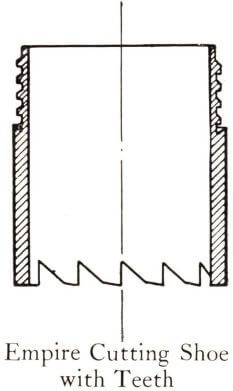 “The cutting shoe of the Empire Hand Drill is equipped with cutting teeth, thus forming a hollow milling cutter which is the ideal tool for cutting a core. When the casing is rotated this shoe cuts a core of the same diameter as the interior diameter of the cutting shoe. The walls of this cutting shoe are of much less thickness than those of the driving shoe used in steam drilling. These thin walls have a strong tendency to get all of the material into the core that properly belongs there. One can readily realize that the thick wall of the steam drill driving shoe will come down upon a small piece of rounded gravel and this gravel will be pushed along down in front of the shoe for a while and ultimately may be included in the core or excluded from it, and the same is true of the small particle of gold. The ideal shoe would be one having walls of no thickness, or rather a knife-edge, which would separate or cut the gravel and its mineral content just as it lies and in this cutting operation all particles belonging to the core would be retained therein while those outside of the shoe would be excluded. This operation would be greatly facilitated by the rotation of the cutting shoe and we would have the ideal method for obtaining a core of an exact known diameter with every particle included within it that properly belongs there. It would appear that the cutting shoe described above comes somewhere near approaching this ideal.
“The cutting shoe of the Empire Hand Drill is equipped with cutting teeth, thus forming a hollow milling cutter which is the ideal tool for cutting a core. When the casing is rotated this shoe cuts a core of the same diameter as the interior diameter of the cutting shoe. The walls of this cutting shoe are of much less thickness than those of the driving shoe used in steam drilling. These thin walls have a strong tendency to get all of the material into the core that properly belongs there. One can readily realize that the thick wall of the steam drill driving shoe will come down upon a small piece of rounded gravel and this gravel will be pushed along down in front of the shoe for a while and ultimately may be included in the core or excluded from it, and the same is true of the small particle of gold. The ideal shoe would be one having walls of no thickness, or rather a knife-edge, which would separate or cut the gravel and its mineral content just as it lies and in this cutting operation all particles belonging to the core would be retained therein while those outside of the shoe would be excluded. This operation would be greatly facilitated by the rotation of the cutting shoe and we would have the ideal method for obtaining a core of an exact known diameter with every particle included within it that properly belongs there. It would appear that the cutting shoe described above comes somewhere near approaching this ideal.
“The thick wall of the driving shoe used in steam drilling, together with its bevel or chamfered edge, offer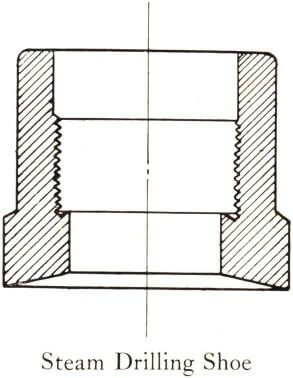 an obstructing surface which causes much material that belongs to the core proper to be either excluded or intruded into the pipe, especially with the heavy driving operations usually employed in the steam drilling work. This I think is the cause of much of the inaccurate work that has been done with this type of drill. The rotation of the cutting shoe with its thin walls and its milling cutting face, tends to cut an accurate core and all the material within the inner circle of this shoe readily enters the casing, remains there and is not driven out by the heavy operations that occur in steam drilling. The simultaneous drilling and pumping of this core as fast as it enters the casing also helps to secure accurate results.
an obstructing surface which causes much material that belongs to the core proper to be either excluded or intruded into the pipe, especially with the heavy driving operations usually employed in the steam drilling work. This I think is the cause of much of the inaccurate work that has been done with this type of drill. The rotation of the cutting shoe with its thin walls and its milling cutting face, tends to cut an accurate core and all the material within the inner circle of this shoe readily enters the casing, remains there and is not driven out by the heavy operations that occur in steam drilling. The simultaneous drilling and pumping of this core as fast as it enters the casing also helps to secure accurate results.
“The usual formula for steam drilling work is 100 feet of 6-inch pipe, representing 1 cubic yard of bank measurement, and calculations are made on the assumption that when the drive pipe is 100 feet in the ground then 1 cubic yard of material has been obtained from the hole. This, of course, assumes that all of the material found within the circle of the outside diameter of the cutting shoe enters the pipe as core, whereas it is pretty generally recognized that this does not happen, in fact, there has been considerable discussion by engineers for many years past on this very point, but it does seem to me that the cutting shoe described above with its rotated action is far more likely to accomplish the purpose than the driving shoe commonly used with the steam drill.”
It is interesting to note that W. A. Pritchard made a report covering some drilling work that he did on the Pato & Nechi Company’s property in Colombia, South America, wherein he used the Empire Hand Drill with its rotated casing and cutting shoe. This report was published in the Engineering and Mining Journal, of January 30, 1915, in which appear the following paragraphs:
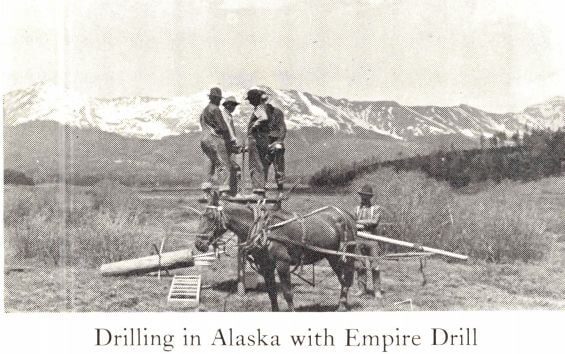 “In the early drilling of the Pato property a theoretical factor arrived at in an entirely different field was necessarily used. For this examination, we had the advantage of a dredge in operation and under our own direction dredged over an area where we had previously drilled 17 holes. Carefully calculating the area and cubic yards represented by each hole and knowing the actual yardage and gold yield by the dredge, we determined mathematically the factor for the drill holes which would give the actual value recovered by the dredge. This factor works out at 387 feet of hole for 1 cubic yard of gravel removed.
“In the early drilling of the Pato property a theoretical factor arrived at in an entirely different field was necessarily used. For this examination, we had the advantage of a dredge in operation and under our own direction dredged over an area where we had previously drilled 17 holes. Carefully calculating the area and cubic yards represented by each hole and knowing the actual yardage and gold yield by the dredge, we determined mathematically the factor for the drill holes which would give the actual value recovered by the dredge. This factor works out at 387 feet of hole for 1 cubic yard of gravel removed.
“This factor of proportion was then used for all of the holes drilled under my supervision on the Pato property. I further checked six of my drill holes by sinking shafts alongside. In this checking, I compared the dry weight of the gravel from both the shaft and drill holes and determined the drill factor for each case on that basis. In those shafts where there were no water difficulties, the factor obtained in this way checked up closely with the factor obtained by dredging. In consequence, the drill results that have been obtained on the Pato ground during this examination are figured more scientifically than is usually possible or considered necessary.
“While this factor of 387 feet of hole equalling 1 cubic yard of gravel removed, was established by actual dredging work, still it coincides closely with the theoretical factor that is used with this hand drill, which is 376. This being based on the area of the inside diameter of the cutting shoe, which is, 10.32 square inches multiplied by 376 feet equals 1 cubic yard. The fact that Mr. Pritchard arrived at this factor by actual dredging work and that it should coincide with the theoretical factor used in the hand drill, tends to prove that the rotated cutting shoe described above does cut an accurate core of known diameter, all of which enables the engineer to test his ground more accurately.
“The Chiksan Gold Mining Co. of Chiksan, Korea, prospected all of its ground with this same type of drill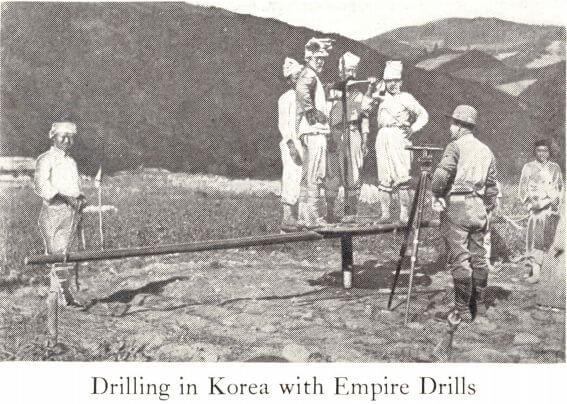 and the subsequent dredging operations checked up the drilling work with remarkable accuracy. A large area of its ground was proved up by some 3,000 drill holes and the prospected value of this ground as indicated by the drilling was 20.90 sen. From January 1, 1918, to January 1, 1920, covering 24 months’ operations, they dredged 4,183,475 cubic yards which produced 904,898 Japanese yen. This production averaged 21.63 sen per cubic yard. The Japanese yen equals about 50 cents in U. S. currency; the sen is equal to about ½ cent.) This data from Company’s annual report 1920.
and the subsequent dredging operations checked up the drilling work with remarkable accuracy. A large area of its ground was proved up by some 3,000 drill holes and the prospected value of this ground as indicated by the drilling was 20.90 sen. From January 1, 1918, to January 1, 1920, covering 24 months’ operations, they dredged 4,183,475 cubic yards which produced 904,898 Japanese yen. This production averaged 21.63 sen per cubic yard. The Japanese yen equals about 50 cents in U. S. currency; the sen is equal to about ½ cent.) This data from Company’s annual report 1920.
“The above operations afford a good example of accurate prospecting and a satisfactory recovery. In doing this work great care was taken to check up the drilling results by shafts. In some instances large pits were sunk after many drill holes had first been put down within the area of the pit itself. It seems to me that this is a most important point and that great care should always be used under all conditions to check any drilling work occasionally by shaft sinking.
“The checking of the core recovered is also another safeguard, but this usually proves difficult on account of measuring the volume of the slimes and determining the space occupied by it when in situ. The expansion of the gravel after being drilled is also difficult to determine and varies in different gravels under different conditions. Its shape, size and proportion of sand carried all affect the factor of expansion of the gravel after excavating.”
A competent engineer with the Empire Drill can prospect a placer property and obtain results that will definitely determine whether or not the ground can be worked at a profit. Furthermore, the data obtained by such drilling, if favorable, will enable us to design a dredge or other mechanical equipment that will insure the most profitable operation of the property.
Exploiting the Property
When sufficient drilling data has been obtained, it remains for the engineer to determine the best method for exploiting the property. This matter is of vital importance and should be entrusted only to a competent and experienced man. Properties have been equipped too often with so-called dry-land dredges or steam shovels, operating in conjunction with portable washing apparatus, and in every instance these plants have ultimately been closed down as failures. They may be so designed as to operate successfully from a mechanical standpoint, but the cost of operation has always proved so high as to exceed the gold recovery, and financial failure has been the invariable consequence.
